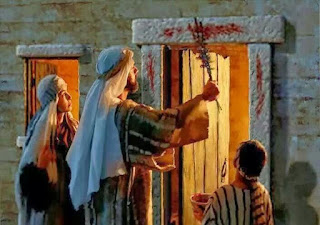March 28- April 3
Exodus 7-13
"Remember this day, in which ye shame out from Egypt"
Materials: paper and crayons, construction paper, scissors, printout (see below), video clip (link below), fresh parsley, pita bread
Opening Song: "Tis' Sweet to Sing the Matchless Love" (Hymns, 177)
Opening Prayer:
Attention Activity: Have family members draw a picture of a nightmare and a hero that could save the day.
Lesson:
Moses had been called by the Lord to ask Pharaoh to free the Hebrews from slavery, but Pharaoh refused. The Lord was not happy with Pharaoh; he said, "For I will at this time send all my plagues upon thine heart, and upon thy servant, and upon thy people; that thou mayest know that there is none like me in all the earth. For now I will stretch out my hand, that i may smite thee and thy people with pestilence; and thou shalt be cut off from the earth" (Exodus 9:14-15).
Activity: 10 Plagues Reveal
Directions: Print the picture below. Using construction paper, cut circles of the same size as those in the image. Tape the construction paper circles over the pictures circles and number them 1-10 accordingly. Have family members take turns taking off the circles in order. Describe each plague as you go using your own words or the passages below.
1: Waters to Blood: The first thing the Lord did to get Pharoh's attention was to have Moses and Aaron (his brother) turn all of the streams, rivers, lakes, and ponds in Egypt to turn from water into blood. All the fish died in the water and it stunk. It lasted for 7 days.
2: Frogs: Read Exodus 8:3
3. Lice: The next plague to come to the Egyptians was lice. Lice are tiny bugs that live in your hair and cause you to itch. Exodus says that all the dust in Egypt was turned to lice that infested all the people and animals in Egypt.
4. Flies: Even after the water was ruined and frogs and lice infested Egypt, Pharaoh still refused to free his Israelite slaves. So the Lord sent swarms of flies into the homes of the Egyptians.
5. Sick Cattle: Read Exodus 9: 6-7
6. Boils: Moses took ashes and threw them in the air in front of Pharaoh. When the ashes drifted down large painful sores called boils appeared on the skins of all the Egyptians including Pharaoh's magicians.
7. Hail and Fire: Pharaoh still wouldn't listen, so the Lord sent a storm--a massive hail storm. Hail is ice that rains from the sky. Sometimes hail can be very large and dangerous like ice cubes the size of baseballs raining from the sky. Along with the hail storm, fire rained down upon the earth.
8. Locusts: Locusts came next to the Egyptians. They are big huge crickets. The Lord sent so many locusts they covered the entire land so you could not see the ground and the sky seemed dark because there were so many flying around. The locusts ate all of the crops that had not already been destroyed in the storm, so the Egyptians had absolutely no food to eat. The locusts filled the houses of the Egyptians.
9. Darkness: For 3 days a thick darkness covered the land in Egypt. The darkness was so bad no one could see each other or light lanterns.
These plagues mainly effected the Egyptians; the Israelite slaves God protected. Moses came to Pharaoh before each plague and begged him to let the Lord's people go free, but Pharaoh hardened his heart and refused.
10. Death of the Firstborn: Moses came to Pharaoh one last time and said, if you don't let the Israelites go, all of the firstborn children and beasts will die. But Pharaoh again didn't listen and threw Moses out.
Activity: Watch The Prince of Egypt passover clip
How did the Lord protect the Israelites from the plague of the firstborn? The Isrealites were told to take a lamb and use its blood to mark their doorways. The lamb would be eaten for dinner along with bitter herbs and unleavened bread. The bitter herbs (show parsley) were to remind them of the bitterness of the captivity and the unleavened bread (show pita bread) was to remind them that there was not time for their bread to rise before they fled their captivity. They had to be ready to go with their loins girded, shoes on their feet, and staff in their hand. They did this and were safe from the plague. Pharaoh, grieving the loss of all the firstborn children finally let the Israelites go.
Every year the Jewish people celebrate the passover. The day before Jesus was crucified, he celebrated the passover meal in what we now call the Last Supper. What did Jesus do at this meal? At the Last Supper Jesus instituted the sacrament. He told the disciples to drink wine in remembrance of his blood and to eat bread in remembrance of his body.
The passover meal and the sacrament have a lot in common. In the passover, blood of the lamb is meant to protect from death. In the sacrament, we drink water to remember the blood that was shed by Jesus, the Lamb of God. The Israelites ate the flesh of the lamb in the passover meal just like we eat the bread to help us remember the body of Christ that died for us. Read Exodus 12:14.
Bear your testimony of the atonement and the sacrament.
Closing Song: "He sent his son" (Children's Songbook, 34)
Closing Prayer:
Refreshment: Matzah bread recipe here



No comments:
Post a Comment